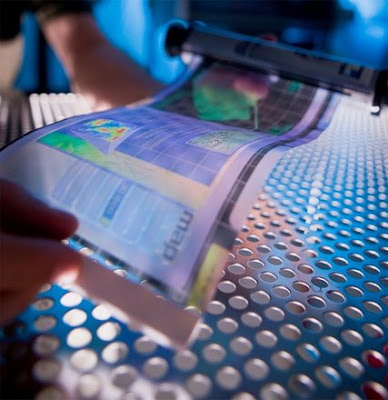Take the newspaper industry. It has been faltering badly under the pressure of new media for a few years. For much of the past decade, circulation for all papers has been declining at about 2% a year. The last year has been a test case of sorts. Newspapers had the story of a lifetime: an election campaign of historic interest, suspense, drama and personality. From Hillary to Barack, from John Edwards’s love child to Sarah Palin’s Down’s syndrome child, from John McCain’s wild lunges for relevance to the first black president, it was the kind of year in which circulation should have boomed. If you live for a story, this year was an embarrassment of riches.
And yet the decline didn’t just continue. It accelerated.
Between March and September the 500 biggest newspapers in America reported an average circulation decline of 4.6%. In six months. That’s close to a 10% decline per year. No newspapers showed any but fractional gains. It is therefore a near-certainty that many towns and cities in America will no longer have a newspaper after the down-turn. And that may apply not just to small names but to some big ones as well. The Los Angeles Times, for example, has gone from a circulation of 1.1m to 739,000 since the turn of the millennium. Its staff has been halved. Morale has never been lower.
Continue reading.
The solution? This:

(Via Engadget.)
Business Wire reports:
Flexible displays are paper-like computer displays made almost entirely of plastic. This technology enables displays to become easily portable and consumes less power than today’s computer displays. Popular applications for the technology could include electronic paper and signage.
The production feat is a milestone in the industry’s efforts to create a mass market for high-resolution flexible displays. Plus, from an environmental standpoint, the displays leapfrog conventional display processes by using up to 90 percent less materials by volume.
Mass production of such displays can enable production of notebook computers, smart phones and other electronic devices at much lower costs since the display is one of the more costly components.
I wrote a column detailing my predictions along these lines a few months back:
Technology enthusiasts have predicted the death of paper for some time now but have traditionally had trouble explaining what would take its place. Despite their usefulness for many tasks, the electronic displays on present-day laptops and other gadgets remain unable to match old-fashioned paper in terms of being lightweight, flexible, and, perhaps most importantly, easy on the eyes. Thus, although many people today, especially the young, get much of their news online, dead-tree publications still serve a unique and vital function.
But those age-old compact sheets of ground-up wood pulp are about to be supplanted by a new medium. If "plastics" was the economic buzzword of the late 1960s, "electronic paper" will likely achieve similar fame in the 2010s. The name may or may not stick, but the development of the technology is already proceeding at a rapid pace. Numerous electronics manufacturers are experimenting with flexible circuits that can be embedded in rubber, producing devices such as screens, keyboards, and touch pads that can be twisted, rolled, or folded without damaging them.
Continue reading.
The news today is particularly grim for daily newspapers, with the Chicago Tribune going bankrupt and the New York Times running out of money. Within the next several years it seems likely that most of the mainstream print media industry is going to suffer a fate similar to that of the famous Hindenberg airship:
The best way forward for primarily text-based media outlets is to move to business models focusing on making content available in as many electronic formats as possible. The flexible displays and electronic paper discussed above are going to proliferate with amazing rapidity over the next couple of years. News organizations that embrace this development and give up on wasting money squirting ink onto paper and shipping it all over the place will survive. The vast majority of those that don't will die. Sure it will be a painful process, but evolution always is.
Make no mistake, the media ecosystem that will grow up on the foundation of ubiquitous flexible electronic displays will be far better than the current print media environment. Barriers to entry will be substantially lower, opportunities for diversity will be greater, and stodgy centralized management will cease to be anything but a liability. So bring on the fiery doom as soon as possible. Only after there are ashes can a phoenix rise from them.
(Cross-posted at The Podium.)
Update:
I've written another blog post expanding on this one: Electronic Newspaper Business Models.
No comments:
Post a Comment